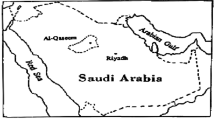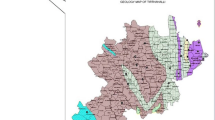Abstract
Activity concentrations of the selected radionuclides 40K, 226Ra and 232Th were measured in surface soil samples collected from 38 cities in the southwest region of Nigeria by means of gamma spectroscopy with a high-purity germanium detector. Measured activity concentration values of 40K varied from 34.9 ± 4.4 to 1,358.6 ± 28.5 Bq kg−1 (given on a dry mass (DM) basis) with a mean value of 286.5 ± 308.5 Bq kg−1; that of 226Ra varied from 9.3 ± 3.7 to 198.1 ± 13.8 Bq kg−1 with a mean value of 54.5 Bq kg−1 and a standard deviation of 38.7 Bq kg−1, while that of 232Th varied from 5.4 ± 1.1 to 502.0 ± 16.5 Bq kg−1 with a mean value of 91.1 Bq kg−1 and standard deviation of 100.9 Bq kg−1. The mean activity concentration values obtained for 226Ra and 232Th are greater than the world average values reported by the United Nations Scientific Committee on Effects of Atomic Radiation for areas of normal background radiation. Radiological indices were estimated for the radiation/health hazards of the natural radioactivity of all soil samples. Estimated absorbed dose rates in air varied from 12.42 ± 2.25 to 451.33 ± 19.06 nGy h−1, annual outdoor effective dose rates from 0.015 ± 0.003 to 0.554 ± 0.023 mSv year−1, internal hazard index from 0.10 ± 0.03 to 3.02 ± 0.16, external hazard index from 0.07 ± 0.01 to 2.60 ± 0.11, representative level index from 0.19 ± 0.03 to 6.84 ± 0.29, activity index from 0.09 ± 0.02 to 3.42 ± 0.15, and radium equivalent activity from 26.95 ± 5.04 to 963.15 ± 41.87 Bq kg−1. Only the mean value of the representative level index exceeds the limit for areas of normal background radiation. All other indices show mean values that are lower than the recommended limits.

Similar content being viewed by others
References
Abe S, Fujitaka K (1980) Natural radiation in Japan. In: Gesell TF, Lowder WM (eds) Natural radiation environment III, vol 2. USDOE, CONF-780422. Technical Information Centre, Oak Ridge, TN, pp 1034–1048
Africa Atlases, Nigeria (2002) Les Editions J.A. p 84
Ajayi OS, Owolabi TP (2008) Determination of natural radioactivity in drinking water in private dug wells in Akure, Southwestern Nigeria. Radiat Protect Dosim 128:477–484
Ajayi OS, Ibikunle SB, Ojo TJ (2008) An assessment of natural radioactivity of soils and its external radiological impact in southwestern Nigeria. Health Phys 94(6):558–566
Al-Jundi J, Al-Tarazi E (2008) Radioactivity and elemental analysis in the Ruseifa municipal landfill, Jordan. J Environ Radioact 99:190–198
Avadhani DN, Mahesh HM, Somashekarappa HM, Karunakara N, Narayana Y, Siddappa K (2001) Natural radioactivity in the environment of Goa of south west coast of India. J Radiat Protect Environ 24(Suppl):136–142
Baeza A, Del-Rio M, Miro C, Paniagua J (1992) Natural radioactivity in soils of the province of Caceres (Spain). Radiat Protect Dosim 45(1/4):261–263
Beck HL, Decompo J, Gologak J (1972) In situ Ge(Li) and NaI(Tl) gamma ray spectrometry. AEC report HASL 258. Health and Safety Laboratory, New York
Beretka J, Mathew PJ (1985) Natural radioactivity of Australian building materials, industrial wastes and by-product. Health Phys 48:87–95
Chougankar MP, Eppen KP, Ramachandran TV (2003) Profiles of doses to population living in the high background radiation areas in Kerala. J Environ Radioact 71:275–297
European Commission (1999) European Commission report on radiological protection principles concerning the natural radioactivity of building materials. Radiat Protect 112
Herbst W (1964) Investigation of environmental radiation and its variability. In: Adam JAS, Lowder WM (eds) Natural radiation environment. University of Chicago Press, Chicago, pp 781–796
Higgy RH, El-Tahawy MS, Abdel-Fattah AT, Al-Akabawy VA (2000) Radionuclide content of building materials and associated gamma dose rates in Egyptian dwellings. J Environ Radioact 50:253–261
International Atomic Energy Agency (IAEA) (1989) Measurement of radionuclides in food and the environment. IAEA technical report series no. 295, Vienna
Isinkaye MO (2008) Radiometric assessment of natural radioactivity levels of bituminous soil in Agbabu, southwest Nigeria. Radiat Meas 43:125–128
Jibiri NN, Farai IP, Alausa SK (2007) Activity concentrations of 226Ra, 228Th and 40K in different food crops from a high background radiation area in Bitsichi, Jos Plateau, Nigeria. Radiat Environ Biophys 46:53–59
Kamath RR, Menon MR, Shulka VK, Sadasivan S, Nambi KSV (1996) Natural and fallout radioactivity measurement of Indian soils by gamma spectrometric technique. In: Proceedings of the fifth national symposium on environment. Saha Institute of Nuclear Physics, Calcutta, pp 56–60
Karunakara N, Somashekarappa HM, Avadhani DN, Mahesh HM, Narayana Y, Siddappa K (2001) Radium-226, 232Th and 40K distribution in the environment of Kaiga of south west coast of India. Health Phys 80:470–476
Karunakara N, Somashekarappa HM, Siddappa K (2005) Natural radioactivity in South West Coast of India. Int Congress Serv 1276:346–347
Krieger VR (1981) Radioactivity of construction materials. Betonwerk Fertigteil Tech 47:468–473
Markkanen M (1995) Radiation dose assessments for materials with elevated natural radioactivity. Report STUK-B-STO 32. Radiation and Nuclear Safety Authority, STUK
Matiullah AA, Shakeel ur Rehman, Shafi ur Rehman, Faheem M (2004) Measurement of radioactivity in the soil of Bahawalpur division, Pakistan. Radiat Protect Dosim 112:443–447
McAulay IR, Moran D (1988) Natural radioactivity in soil in the Republic of Ireland. Radiat Protect Dosim 24:47–49
Merdanoglu B, Altinsoy N (2006) Radioactivity concentrations and dose assessment for soil samples from Kestanbol granite area Turkey. Radiat Protect Dosim 121:399–405
Mustapha AO, Patel JP, Rathore IVS (1999) Assessment of human exposure to natural sources of radiation in Kenya. Radiat Prot Dosim 82(4):285–292
NEA-OECD (1979) Exposure to radiation from natural radioactivity in building materials. In: Report by the group of experts of the OECD Nuclear Energy Agency (NEA), Paris
Ohlsen H (1971) Determination of the mean population burden from natural external radiation in the German Democratic Republic. SZE-14/69 and AEC-tr-7216
Oshin IO, Rahaman MA (1985) Uranium favourability studies in Nigeria. J Afr Earth Sci 5(1):167–175
Rahaman MA (1976) Review of basement geology of southwestern Nigeria. In: Kogbe CA (ed) Geology of Nigeria. Elizabethan Publication, Lagos, pp 47–58
Rahaman MA (1988) Recent advances in the study of the basement complex of Nigeria. In: Proceedings of first symposium on the precambrian geology of Nigeria, pp 11–43
Saito K, Jacob P (1995) Gamma ray fields in the air due to sources in the ground. Radiat Protect Dosim 58:29–45
Saito K, Petoussi N, Zankl M (1990) Calculation of organ doses from environmental gamma rays using human phantoms and Monte Carlo methods. Part I. Monoenergetic sources of natural radionuclides in the ground, GSF-B2/90
Shiva Prasad NG, Nagaiah N, Ashok GV, Karanukara N (2008) Concentrations of 226Ra, 232Th and 40K in the soils of Bangalore Region, India. Health Phys 94(3):264–271
Stranden E (1976) Some aspects on radioactivity of building materials. Phys Nor 8:167–173
Tahir SNA, Jamil K, Zaidi JM, Arif M, Ahmed N, Ahmed SA (2005) Measurements of activity contents of naturally occurring radionuclides in soil samples from Punjab province of Pakistan and assessment of radiological hazards. Radiat Protect Dosim 113:421–427
Turhan S (2008) Assessment of the natural radioactivity and radiological hazard in Turkish cement and its raw materials. J Environ Radioact 99:404–414
United Nations Scientific Committee on Effects of Atomic Radiation (UNSCEAR) (1988) Sources and effects of ionizing radiation. UN, New York
United Nations Scientific Committee on Effects of Atomic Radiation (UNSCEAR) (1993) Sources and effects of ionizing radiation. UN, New York
United Nations Scientific Committee on Effects of Atomic Radiation (UNSCEAR) (1998) Sources and effects of ionizing radiation. UN, New York
United Nations Scientific Committee on Effects of Atomic Radiation (UNSCEAR) (2000) Report to the general assembly, vol I. Sources and effects of ionizing radiation. United Nations, New York
Yang Y, Wu X, Jiang Z, Wang W, Lu J, Lin J, Wang LM, Hsia Y (2005) Radioactivity contents in soils of Xiazhuang granite area, China. Appl Radiat Isot 63:255–259
Acknowledgments
The author gratefully acknowledges the assistance given by Messers S.B. Ibikunle, T.J. Ojo and Mrs. Mosunmola Bello in collecting samples. The assistance of Dr. I.R. Ajayi in sample analysis is also acknowledged.
Author information
Authors and Affiliations
Corresponding author
Rights and permissions
About this article
Cite this article
Ajayi, O.S. Measurement of activity concentrations of 40K, 226Ra and 232Th for assessment of radiation hazards from soils of the southwestern region of Nigeria. Radiat Environ Biophys 48, 323–332 (2009). https://doi.org/10.1007/s00411-009-0225-0
Received:
Accepted:
Published:
Issue Date:
DOI: https://doi.org/10.1007/s00411-009-0225-0




